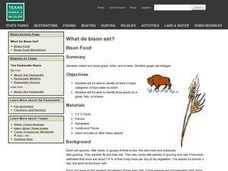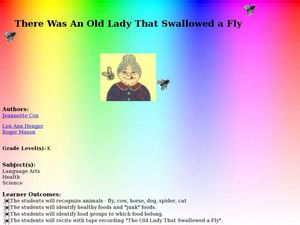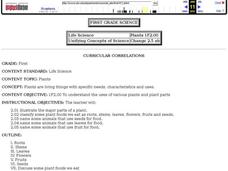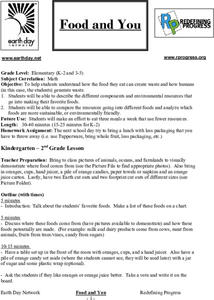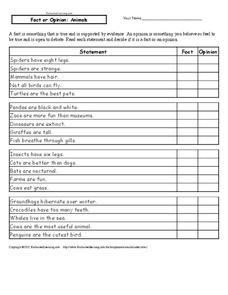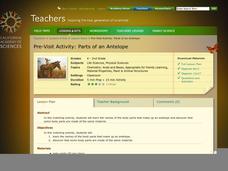Curated OER
What do Bison Eat?
Students identify the three major categories of food eaten by bison. In groups, they collect examples of grass and forbs and press them. They complete a chart of the percentages of each type of food the bison eat in a day. They...
Curated OER
Where Does Food Come From?
Distinguish between food and non-food items. Recognize that food is obtained from both plant and animal sources. Identify sources for some common animal foods then construct a simple food path from the farm to the consumer.
Curated OER
4-H Dairy Activity Page; Ethical Decision Making
Get your 4-H farmers ready for their dairy project with this activity page, which focuses on helping students form ethical decisions. A variety of activities, including a scavenger hunt, a word search and viewing the anatomy of a dairy...
Curated OER
Food Choices: A Socio-Cultural Decision
Students discuss their food preferences. Using a flannel board and food models students describe what they would like to eat for dinner. Students compare their selections with their classmates. Students identify the nationality of ethnic...
Curated OER
Elephants
In this elephants worksheet, students read a 2 page article on the history of elephants, answer 3 questions with multiple choice answers, list the 3 reasons for animals becoming endangered and answer 6 statements as true or false.
Curated OER
They Don't Just Eat Grass
Students explore and examine different types of feed used for livestock. They discuss types of feed, the need for energy and health, and create graphs of food compared to categories. Students organize data and complete worksheets on...
Curated OER
There Was An Old Lady That Swallowed a Fly
Students complete activities with the book There Was An Old Lady That Swallowed a Fly. For this literature lesson, students hear the story and recognize the animals. They create fly soup and discuss healthy foods and junk foods.
Curated OER
Cows, Worms, and Compost
Students study decomposition. For this decomposition lesson, students discuss the background information about decomposition. Students then complete the 'Chew It Twice' worksheet.
Curated OER
Building YOU from MOO
Students build protiens according to whether they are suppose to be a plant, a cow, or a person. They discover that all proteins are made from the same amino acids and it is just the order of these amino acids that change.
Curated OER
Building You From Moo
Students are given an envelope that turns each of them into either a field of grass, or a diary cow, or a famous person (only one type of organism per student). The object is to get the correct building blocks for proteins (amino acids)...
Curated OER
Farm Animals
First graders use this Web Quest to find out about 6 different farm animals. They explore what each animal eats and what food humans get from each animal. They study about are pigs, sheep, goats, horses, cows, and chickens.
Curated OER
Plants
Students illustrate the major parts of a plant, classify some plant foods we eat as roots, stems, leaves, flowers, fruits and seeds. They also name some animals that use seeds, leaves, and fruit for food.
Curated OER
Pigs
Learners read books, learn about the letter p, and eat pigs n mud all to learn about pigs. For this pigs lesson plan, students also dance with pink ribbons and make pigs out of construction paper.
Curated OER
Who Made Breakfast
Students examine animal rights by researching factory farm methods. In this animal abuse lesson, students identify how many ingredients used in their breakfast come from animals. Students research the health hazards caused to humans by...
Curated OER
Owl Pellets
Students discover the contents of an owl pellet. In this science lesson plan, students explore the eating habits of owls and compare the contents of an owl pellet to the human skeletal system.
Curated OER
Plant or Animal Matching Worksheet
For this plant and animal matching worksheet, learners examine pictures of either plant or animal products before drawing a line to either a cow or a tomato plant.
Curated OER
Food and You
Young scholars examine the types of foods they eat. They describe the different components and resources that go into making their favorite foods. They also compare the resources going into different foods and identify ones which are...
Curated OER
Explorit's Tasty Food Quiz
In this foods activity, students complete a five question multiple choice online interactive activity about foods that we eat.
Curated OER
The Importance of Trade
Young scholars discuss how trade affects the products they use everyday. In groups, they identify the clothes they are wearing, the food they eat most often and the cars their families drive. Using the internet, they research how these...
Curated OER
COLORS ON THE FARM
Students follow directions regarding what colors farm objects should be
colored. They identify various items pictured on provided worksheet that can be found on a farm or are made from farm animals. Finally, they match each color crayon...
Curated OER
Fact or Opinion: Animals
How many legs do spiders have? Is that an opinion, or is it a fact? Complete a worksheet with four sets of five questions about different animals and their attributes, noting whether each statement is a fact or an opinion.
California Academy of Science
Parts of an Antelope
There are so many wonderful parts to an animal: fur, antlers, tails, and legs, to name a few. A large diagram of an antelope is used to start a matching game, where the class matches body parts made of the same material. They discuss...
Curated OER
Folk and Popular Culture
Good enough for a college class, this resources discusses multiple aspects pertaining to the issues with globalization and the differences between pop and folk culture. It defines major terminology, provides concrete examples, and...
Curated OER
ASL: Lesson 10
Focus on learning how to sign cardinal and ordinal numbers, nouns, and lexicalized fingerspelling. Here is lesson 10 of the series on learning ASL. Provided, are multiple links that provide a visual guide to proper signing. Teach your...


